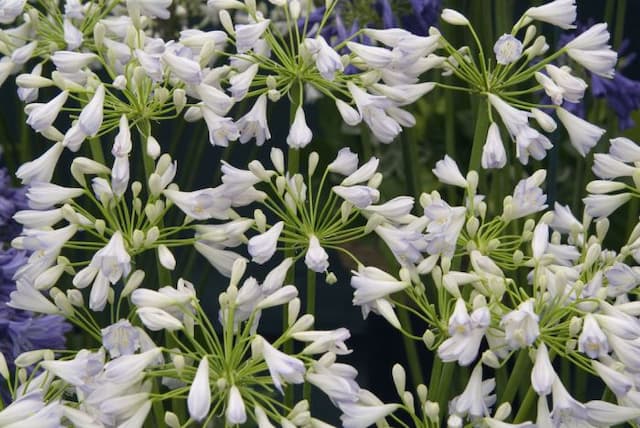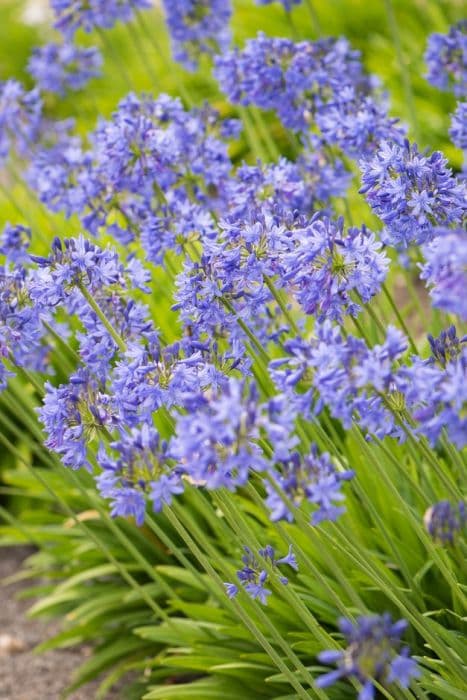Lily of the Nile Agapanthus 'Snow Pixie'

ABOUT
The Agapanthus 'Snow Pixie' is an ornamental plant featuring a striking appearance. It is characterized by a clump of lush, strap-like foliage that creates a mound of greenery. The leaves are a deep, glossy green, presenting a fresh look throughout the growing season. However, the true spectacle of 'Snow Pixie' lies in its flowers. This plant boasts clusters of trumpet-shaped blooms arranged in spherical umbels, each a pristine white, which can appear almost luminescent against the contrast of the dark foliage. The blossoms emerge on tall, slender stalks that rise gracefully above the foliage, creating an airy and elegant display that is visually striking. The combination of the verdant leaves and the pure white flowers gives the Agapanthus 'Snow Pixie' a fresh and crisp appearance that enlivens any garden setting where it is planted.
About this plant
 Names
NamesSynonyms
African Lily, Lily of the Nile, Love Flower.
Common names
Agapanthus 'Snow Pixie'.
 Toxicity
ToxicityTo humans
The Lily of the Nile is considered mildly toxic to humans if ingested. While severe poisoning is rare, consuming parts of the plant can potentially cause gastrointestinal symptoms such as nausea, vomiting, and diarrhea. In some cases, it may lead to dermatitis when there is skin contact with its sap.
To pets
The Lily of the Nile is toxic to pets, such as dogs and cats. If ingested, it can cause symptoms like nausea, vomiting, and diarrhea. More severe reactions may include abdominal pain, salivation, lethargy, and tremors. It's important to seek veterinary care if you suspect your pet has ingested this plant.
 Characteristics
CharacteristicsLife cycle
Perennials
Foliage type
Evergreen
Color of leaves
Green
Flower color
White
Height
1-2 feet (30-60 cm)
Spread
1-2 feet (30-60 cm)
Plant type
Bulb
Hardiness zones
8
Native area
South Africa
Benefits
 General Benefits
General Benefits- Ornamental Appeal: Adds aesthetic value to gardens with its striking white flowers and lush foliage.
- Low Maintenance: Requires minimal care once established, making it ideal for busy gardeners.
- Drought Tolerance: Can survive with little water, making it suitable for xeriscaping or drought-prone areas.
- Attracts Pollinators: Flowers are attractive to bees, butterflies, and other pollinating insects, promoting biodiversity.
- Long Blooming Season: Provides a long period of visual interest with its extended blooming time.
- Container Gardening: Well-suited for pots and containers, allowing for versatility in garden design and placement.
- Deer Resistance: Less likely to be eaten by deer, ensuring your garden stays intact and beautiful.
- Perennial Growth: Comes back year after year, reducing the need to replant annually and providing long-term garden structure.
- Border Planting: Ideal for use in borders due to its neat clumping habit and attractive flower stalks.
 Medical Properties
Medical PropertiesThis plant is not used for medical purposes.
 Air-purifying Qualities
Air-purifying QualitiesThis plant is not specifically known for air purifying qualities.
 Other Uses
Other Uses- Container Gardening: Agapanthus 'Snow Pixie' is highly suitable for container gardening due to its compact size, providing an aesthetically pleasing display on patios or balconies.
- Edging Plants: This plant can be used to create defined edges in a garden, giving a clean and organized visual effect.
- Water-wise Gardens: As a drought-tolerant plant, it is an excellent choice for water conservation landscapes or xeriscaping.
- Seasonal Interest: Its white flowers can be a point of interest in summer-themed gardens when other plants may not be in bloom.
- Thematic Designs: Can be used in thematic gardens such as white gardens where a monochromatic display is desired.
- Artistic Inspirations: Artists and photographers may use the striking blooms of Agapanthus 'Snow Pixie' as subjects for their work due to its unique form and color.
- Curb Appeal: Planting this variety near the front of a house can enhance curb appeal with its neat, compact appearance and attractive flowers.
- Wildlife Garden: The flowers attract pollinators like bees and butterflies, enriching the biodiversity of garden ecosystems.
- Moon Gardens: Since the blooms are white, they can be incorporated into a moon garden where they will reflect moonlight and create a luminous night-time garden.
- Focal Point: Due to its distinctive look, it can serve as a focal point in rockeries or central features in small garden spaces.
Interesting Facts
 Feng Shui
Feng ShuiThe Agapanthus is not used in Feng Shui practice.
 Zodiac Sign Compitability
Zodiac Sign CompitabilityThe Agapanthus is not used in astrology practice.
 Plant Symbolism
Plant Symbolism- Love Letters: The word "Agapanthus" is derived from the Greek words 'agape' meaning love, and 'anthos' meaning flower. As such, they are often seen as symbolic of love letters or messages.
- Beauty: Snow Pixie, with its striking white flowers, can symbolize beauty, purity, and elegance.
- Enduring Love: Agapanthus plants are perennials, returning year after year, which can symbolize an enduring or everlasting love.
- Home: Opinions suggest that because Agapanthus often flourishes in a garden setting, they can represent the safety, comfort, and beauty of the home.
- Fertility: Due to their lush foliage and round clusters of flowers, they are sometimes seen as symbols of fertility or abundance.
 Water
WaterLily of the Nile, commonly referred to as 'Snow Pixie,' should be watered thoroughly, allowing the soil to become slightly dry between waterings. It's generally best to water this plant once a week, providing about one gallon of water to ensure deep soil moisture, which will promote healthy root development. During the hotter seasons, you may need to water more frequently, especially if the plant is outdoors and the weather is dry. However, during the winter dormant period, reduce watering to every few weeks, just enough to prevent the soil from completely drying out.
 Light
LightLily of the Nile thrives in full sun to partial shade. The ideal spot for 'Snow Pixie' is an area where it receives at least six hours of direct sunlight daily, but it can also tolerate some light afternoon shade. Avoid deep shade as this can reduce blooming and weaken the plant's overall health.
 Temperature
TemperatureThe Lily of the Nile prefers temperate conditions and can generally withstand temperatures as low as 25 degrees Fahrenheit but not for extended periods. Ideally, this plant thrives in temperatures ranging from 50 to 80 degrees Fahrenheit. To prevent cold damage, it is advisable to provide some protection or bring the plant indoors if temperatures are expected to drop below the minimum threshold.
 Pruning
PruningPrune the Lily of the Nile to remove spent flower stalks and to tidy the plant's appearance after blooming, usually in late summer or fall. Pruning helps encourage new growth and more abundant blooms for the following season. Cut back dead foliage in the spring to make way for new shoots, typically doing this once a year.
 Cleaning
CleaningAs needed
 Soil
SoilThe best soil mix for the Lily of the Nile 'Snow Pixie' should be rich, well-draining, and loamy. It should have a pH between 6.0 and 8.0, slightly acidic to slightly alkaline. A combination of two parts loam, one part perlite, and one part compost would be ideal to ensure good drainage and fertility.
 Repotting
RepottingLily of the Nile 'Snow Pixie' should generally be repotted every 2 to 3 years. Repotting should be done in the spring, and one can upsize the pot if the plant's rhizomatous roots have filled the current container.
 Humidity & Misting
Humidity & MistingLily of the Nile 'Snow Pixie' does well in moderate humidity levels but is quite adaptable. The best humidity level for this plant is around 40% to 60%.
 Suitable locations
Suitable locationsIndoor
Provide bright light, well-draining soil, and periodic water for indoor growth.
Outdoor
Grow in full sun to part shade, in well-draining soil with moderate water.
Hardiness zone
8-11 USDA
 Life cycle
Life cycleAgapanthus 'Snow Pixie', commonly known as Lily of the Nile, begins its life as a seed, which, when sown, germinates in moist, well-draining soil. After germination, the seedling grows into a young plant with strap-shaped leaves and establishes a fleshy, root system. As it matures, it forms an evergreen clump of foliage and, in summer, sends up tall flower stalks topped with rounded clusters of trumpet-shaped, white flowers. After flowering, seed pods may develop, and once they dry, they release seeds to propagate the next generation. During the winter or in colder climates, the plant may die back, remaining dormant until the following spring. Throughout its life, Agapanthus 'Snow Pixie' will continue to expand in size and may require division to manage its spread and to rejuvenate growth.
 Propogation
PropogationPropogation time
Spring-Early Summer
The Agapanthus 'Snow Pixie', also known as the Dwarf Lily of the Nile, can be propagated primarily by division, which is the most popular method for this plant. This process is typically done in the spring or early summer when the plant has finished blooming and the weather is warm. To propagate by division, the gardener should carefully remove the plant from the ground or container, shake off excess soil, and then gently tease apart the root ball into smaller clumps, ensuring that each clump has a portion of the roots and at least one or two growing points. These clumps can then be immediately replanted in well-draining soil, spaced at least 12 inches (approximately 30 centimeters) apart to allow for adequate growth room. Regular watering and partial to full sun exposure will encourage the new plants to establish and thrive.









